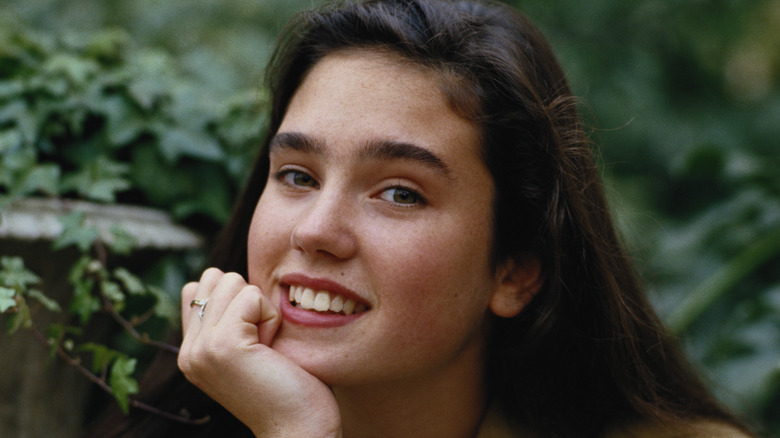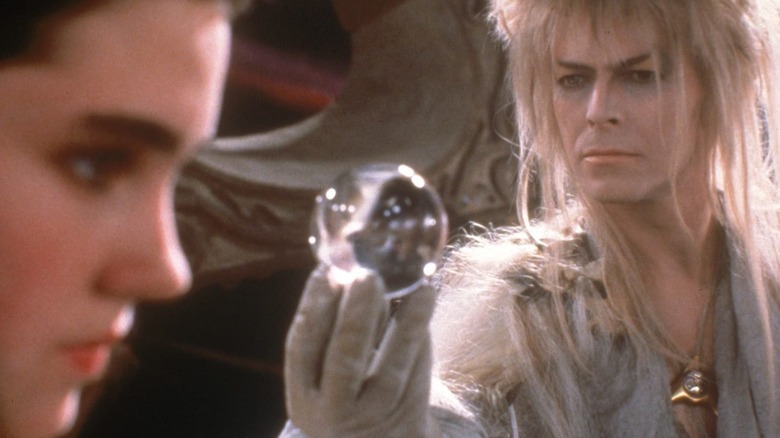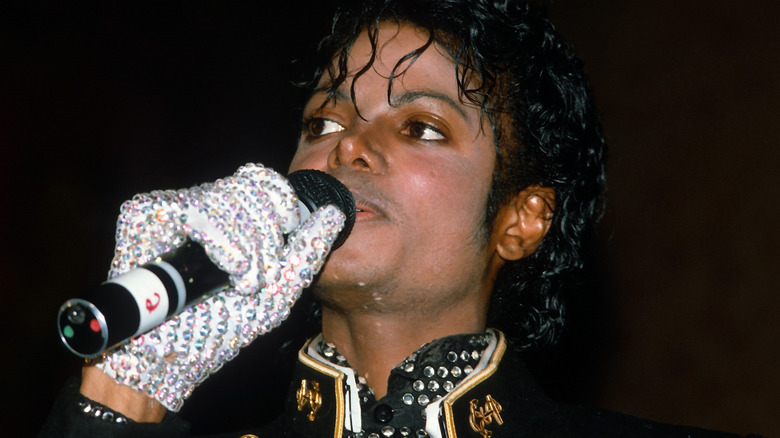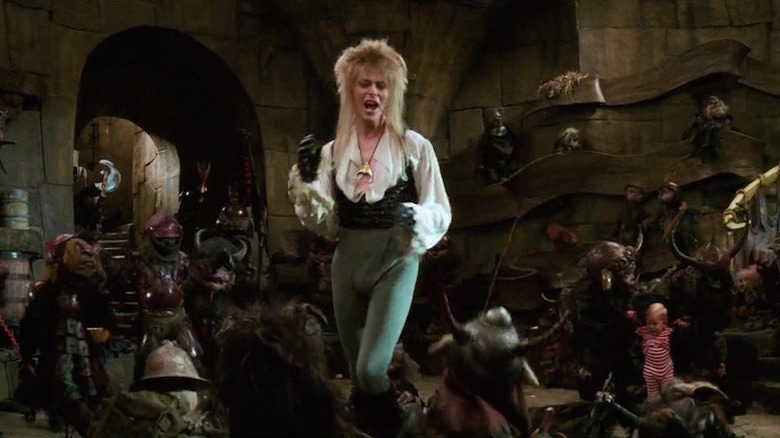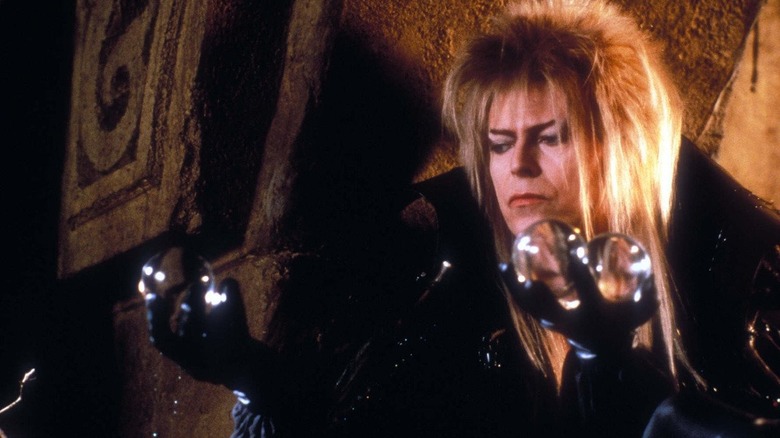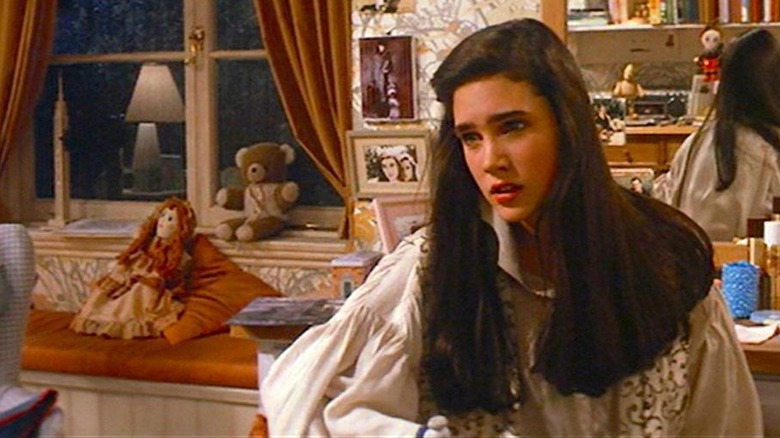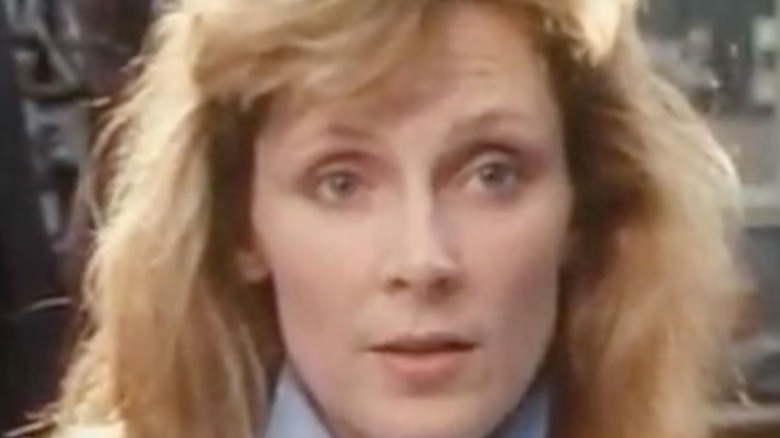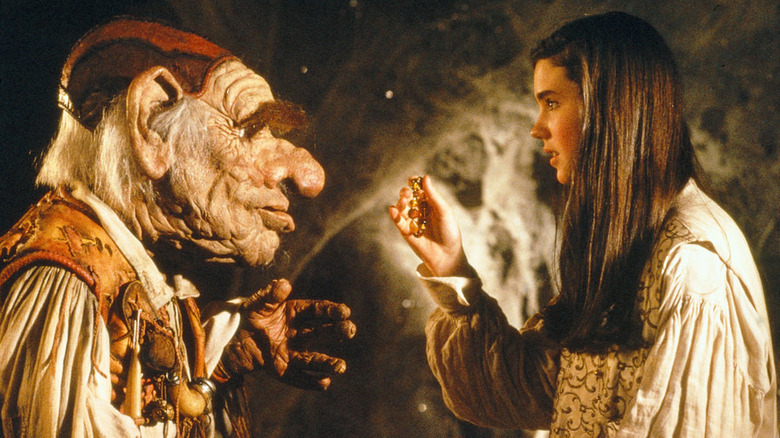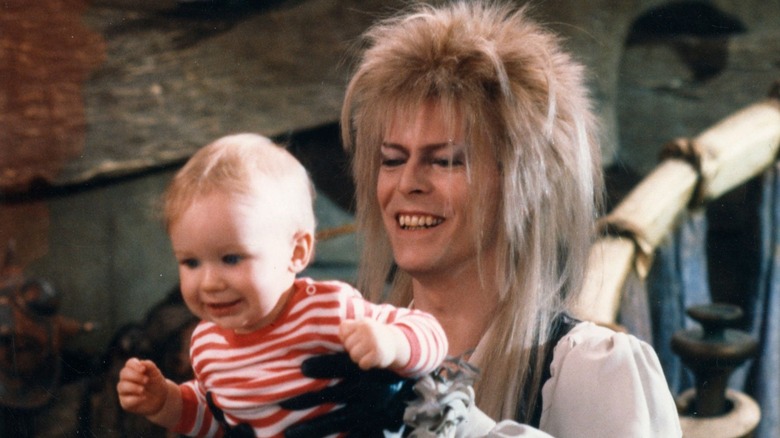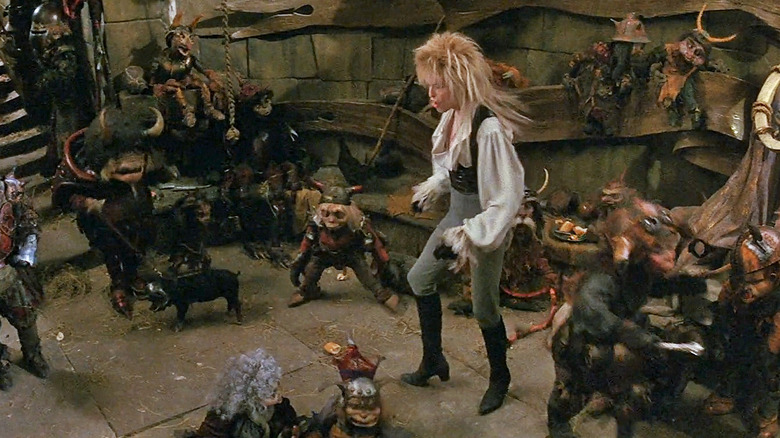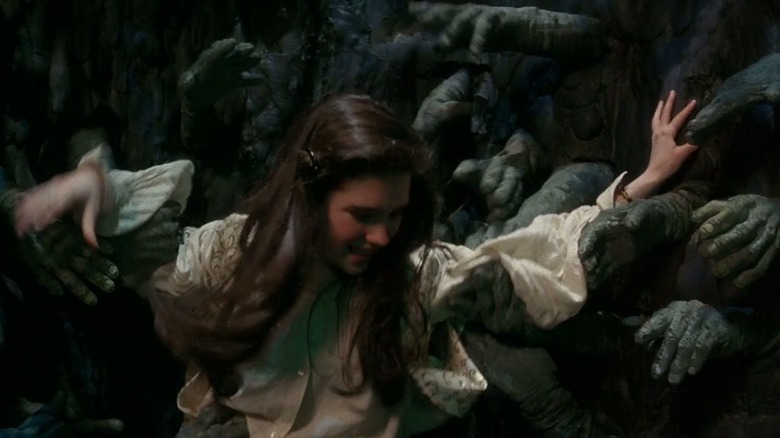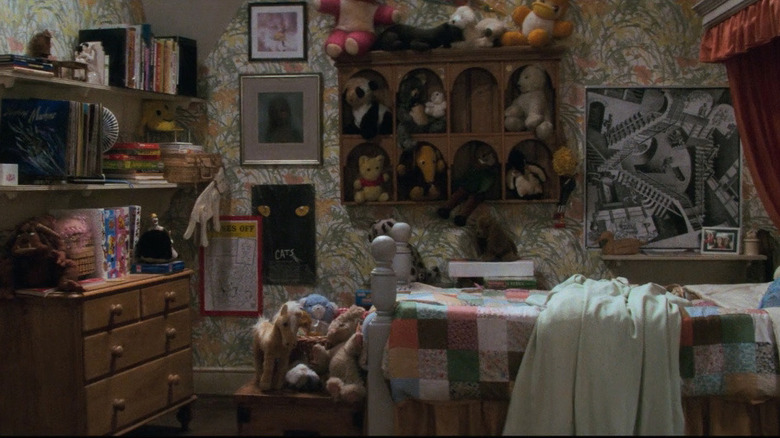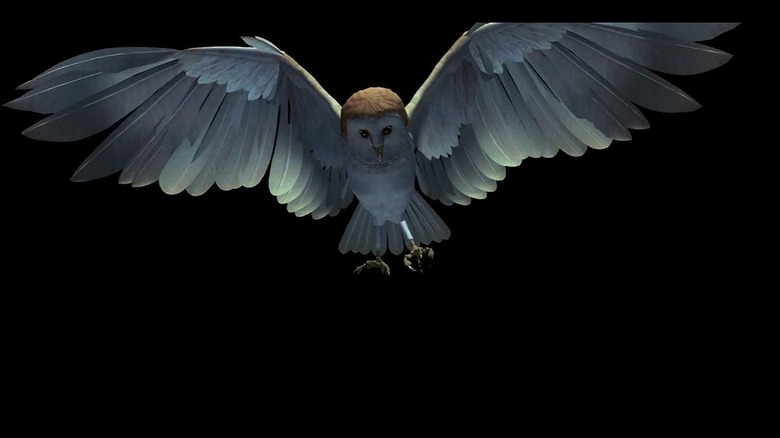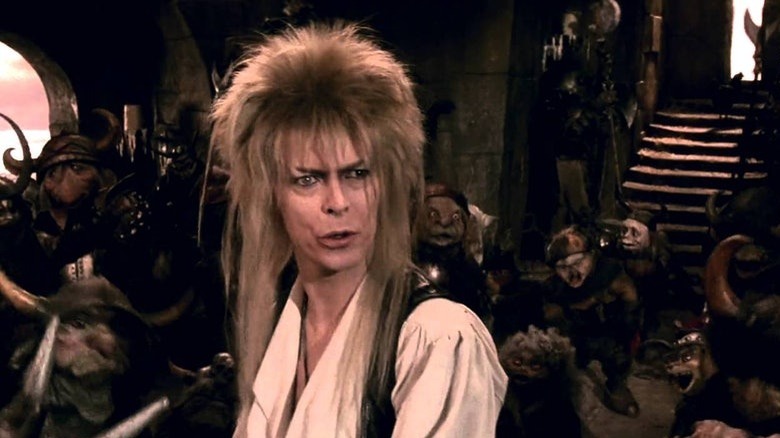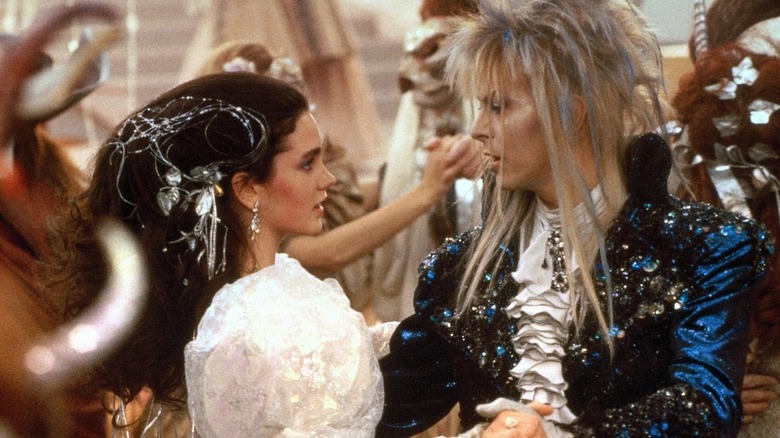The Untold Truth Of Labyrinth
The 1986 musical fantasy film "Labyrinth" is a millennial cult classic. Written and directed by master puppeteer Jim Henson, the film utilizes his creature shop skills to create a world of goblins, magical creatures, and fantastical locations to transport viewers into a place that's as frightening as it is fascinating. The story tells of a young teenage girl named Sarah (Jennifer Connelly) who "accidentally" wishes that her baby step-brother Toby be taken away by the Goblin King Jareth (David Bowie). Jareth grants her request, leading Sarah on an epic adventure through a tricky labyrinth where she encounters friends, foes, and all kinds of masterfully crafted Henson characters.
"Labyrinth" was made just after Henson and conceptual designer Brian Froud's first feature, "The Dark Crystal." As Henson told Starlog Magazine, "We wanted to do a lighter weight picture, with more of a sense of comedy since 'Dark Crystal' got kind of heavy, heavier than we had intended. Now I wanted to do a film with the characters having more personality, and interacting more," Henson said. But the untold truth of "Labyrinth" goes much deeper than that (underground, even). Here are some more things you might not know about your favorite childhood cult hit.
The script was written by many hands
When Henson and conceptual designer Froud started out on their "Labyrinth" journey shortly after completing "The Dark Crystal," all they had was an idea and some of Froud's designs to work with. Froud gave his drawings to Terry Jones of the comedy troupe Monty Python in 1984. Jones wrote the first draft of a script that would get written and rewritten by many different writers. "Fraggle Rock" writer Laura Phillips also wrote a script, according to New York Times reports from the era. Comedian and actor Elaine May did some rewrites, as did children's writer Dennis Lee. George Lucas, whom we've all heard of and who executive-produced "Labyrinth," also did some edits and additions.
Jones and Henson may have had different ideas as to what "Labyrinth" should be about, but that didn't stop them from working well together, even if the script went through many hands. The script "went away for about a year," Jones says in the book "Life Before and After Monty Python — The Solo Flights of the Flying Circus," adding: "When the script came back, I didn't recognize any of it." Even so, he says, "Jim was great, really smashing to work with — even when we disagreed on things. He was always open to other ideas."
Jareth was almost played by Michael Jackson
"Labyrinth" wouldn't be "Labyrinth" without legendary rock star David Bowie playing the Goblin King Jareth. But what if it hadn't been David Bowie? According to Starlog Magazine, Jareth was going to be just another of Henson's puppets, albeit a grandiose one to rule the labyrinth and goblin world. But Henson changed course and wanted a real human to play Jareth, but not just any human, Henson wanted a musical person, someone who would "change the film's whole musical style." Musicians considered for the part of Jareth reportedly included Sting, Prince, Mick Jagger, and even Michael Jackson, as the 1986 television documentary "Inside the Labyrinth" details.
"We thought of several people," Henson says in Starlog, "but by far the one that was most exciting to us was David Bowie." Apparently, Henson's kids loved David Bowie, and encouraged him to go with the Thin White Duke himself. "I had no idea whether he would consider singing in a film, since at that point he never had." But Bowie was on board after seeing Henson's previous film, "The Dark Crystal." In the documentary, he says, "They brought me the concept...[Henson] showed me 'The Dark Crystal,' which I found a fascinating piece of work. And I could see the potentiality of making that kind of movie, with humans, songs, more of a lighter comedy." There's an alternate universe in which Michael Jackson's Jareth was probably really cool, but Bowie's version is iconic.
Jareth's look (and bulge) are very intentional
One of the things that made Jareth so cool was his overall look and design. The iconic David Bowie was used to dressing in elaborate costumes throughout his musical career, but Jareth's mix of goth Victorian and Halloween drag was a whole new arena. As producer George Lucas put it in the "Inside the Labyrinth" documentary, Jareth is basically supposed to be the devil, so making him frightening but alluring was the goal. To do so, conceptual designer Brian Froud put armor on Jareth's leather jacket, referencing the armor of 15th-century knights. Jareth's scepter, which Froud calls a "swagger stick," actually looks like a microphone, alluding of course to Bowie's rock star status.
The most surprising element of Jareth's costuming, however, is that the iconic Bowie "bulge" was done on purpose. Fans of "Labyrinth" know how famously tight Bowie's pants are throughout the film, and Froud says that was intentional. "He was supposed to be a young girl's dream of a pop star," Froud says in the doc. "We got in a lot of trouble about maybe how tight his pants were but that was deliberate." So no, you're not just hyper-focusing on a certain area of David Bowie's body because you're a skeeve — the filmmakers wanted you to hyper-focus on a certain area of David Bowie's body.
David Bowie did not really juggle the glass crystals
David Bowie may have totally looked the part of Jareth the Goblin King, but he wasn't able to do everything. One of the coolest things in "Labyrinth" was Jareth's skillful juggling and manipulating of glass orbs. But despite his best efforts, Bowie just couldn't juggle balls with the same talent as choreographer Michael Moschen.
Getting the look of Jareth juggling those crystal balls wasn't easy. As you can see in the making-of documentary "Inside the Labyrinth," Moschen had to crouch behind Bowie wearing one piece of Bowie's costume and do all of his tricks and slick turns completely blind. It looks incredibly difficult, which only adds to the magic of the entire movie. Henson points out that Bowie was very patient while they got everything right. "I had fun!" Bowie says of the juggling double crouched behind him, "but I don't think Michael Moschen had much fun. It was agonizing for him."
Casting Sarah
Finding the right Sarah was as imperative as finding the right Jareth. When Henson and Froud started designing the film, Henson explained in Starlog Magazine, Sarah was originally going to be a princess in a fantasy world. Then she shifted to being a Victorian girl. But eventually, Henson bumped Sarah into contemporary times. The team started to look for 18-year-olds, but that age didn't vibe with the film's "growing up process of maturity, working with the idea of a young girl right at that point between girl and woman." A ton of now-famous actors auditioned for the role, including Helena Bonham Carter, Sarah Jessica Parker, Jane Krakowski, Yasmine Bleeth, Marisa Tomei, Mary Stuart Masterson, Lili Taylor, Laura San Giacomo, Laura Dern, Ally Sheedy, and Mia Sara. Looking at their old headshots for the audition is a fun trip back in time.
But it was then 14-year-old Jennifer Connelly who won Henson over. " She was right at the moment between child and woman," Hensons says in Starlog. "Some of the time when you talked to her, she was like a child. And at other times, she was very much like a young woman."
The connection with Star Trek: The Next Generation
Most sci-fi and fantasy fans know Gates McFadden as Dr. Beverly Crusher on "Star Trek: The Next Generation." But before McFadden boldly went where no one had gone before, she was a dancer and choreographer in addition to being an actor. McFadden uses her real first name Cheryl (Gates is her middle name) in all of her dance- and choreography-related jobs. For "Labyrinth," she was the Director of Choreography and Puppet Movement, a job she also did on other Jim Henson projects, like "The Dark Crystal" and "The Muppets Take Manhattan."
McFadden didn't just use her dance skills to choreograph dance sequences such as the Fireys or the epic ballroom dance scene, but she also helped the puppeteers and actors choreograph their movements and work with the incredibly difficult costumes. Watching McFadden work with the puppeteers, dancers, and cast members in this behind-the-scenes footage offers an interesting glimpse into McFadden's work life off of the Enterprise.
The puppets were state of the art
The puppets created for "Labyrinth" by Jim Henson's Creature Shop were some of the most complicated but most dazzling they ever did. For example, let's start with the dwarf Hoggle, the Jareth lackey turned Sarah sympathizer. While there was an actor named Shari Weiser inside the actual Hoggle suit, his face was made up of 18 motors and took four people to operate. Brian Henson, Jim's son, voiced the character. But after all of that work, Hoggle was lost! He was misplaced during airline transit, discovered by a baggage employee, and now resides at the Unclaimed Baggage Museum in Scottsboro, Alabama.
The second most complicated puppet, the giant but loveable Ludo, weighed over 100 pounds at first, but the team managed to get it down to about 75 pounds. Even so, the weight was still quite imposing, so they alternated actors inside the costume, both puppeteers Ron Mueck and Rob Mills spent time inside Ludo, with Mueck providing the voice. But Ludo was treated a little more royally than the lost Hoggle: Ludo got to meet Princess Diana and Prince Charles at the film's London premiere.
Baby Toby wasn't just a random baby
Baby Toby had one of the hardest jobs in the movie: cry a lot. Well, maybe that's easy for a baby. But what might be hard is watching your baby cry a lot. That's what the film's conceptual designer, Brian Froud, had to endure throughout the shoot. You see, Baby Toby was actually played by Toby Froud, Brian Froud's son. Though he was only about a year old when the film was shot, Toby Froud tells Portland Monthly that, "I have vivid memories of goblins' faces and strange creatures and chaos around me that could just be from growing up in the house I lived in, or from seeing the film as many times as I have, or it could be remembering the puppets that were in front of me. I'm not sure." He does, however, believe that he peed on David Bowie the first time he sat in his lap.
Froud went on to join the family business, becoming a puppeteer himself. He went to Wimbledon School of London for a special effects and arts degree. He then interned with Jim Henson Studios and worked for Laika. He's worked on the films "ParaNorman," "The Boxtrolls," "Kubo and the Two Strings," and the Netflix reboot series "The Dark Crystal: Age of Resistance." His next project is the Guillermo del Toro version of "Pinocchio."
It's a family business
Toby Froud wasn't the only "Labyrinth" family member who was involved in the film or continued in the puppetry and entertainment business. Specifically for "Labyrinth," the team also had Brian Henson, who worked alongside his father doing multiple puppets, including the aforementioned Hoggle. Henson's daughter Cheryl was the puppeteer for one of the Firey dancers.
Henson's other kids also continue in the family business. Henson's kids run his company and foundation. His daughter Lisa is a former actor, television and film producer, and is now the CEO of The Jim Henson Company. Cheryl, in addition to working on "Labyrinth," worked on the Muppets beginning in high school and the Sesame Workshop. She's now a board member of The Jim Henson Company. John Henson was also a puppeteer, but like his dad passed away at an early age. And Heather Henson is a puppeteer as well and serves on the various Henson company and foundation boards. She also collaborated with Toby Froud on a short film called "Lessons Learned" that utilized the designs of both of their fathers.
The helping hands are real hands
One of the things that make "Labyrinth" so amazing is its use of almost all practical effects. That includes the terrifying shaft of "helping hands" that Sarah falls down on her way to the oubliette. Even watching the behind-the-scenes making-of footage from "Inside the Labyrinth" gives you the heebie-jeebies.
To achieve the effects, the team created hundreds and hundreds of latex hands, some of which were filled with foam and placed into the shaft, and some that would be gloves to go on the puppeteer's hands in order to make the faces. The entire pit was about 40 feet tall, with Connelly strapped to a dangerous rig that would raise her up and down while they shot the scene. Connelly said of the shoot, "It was fun! Some of the hands passed me little notes during breaks, others tried to communicate in sign language." Henson added, "It's certainly one of the most bizarre and unusual sequences I've ever used in a movie. But then 'Labyrinth' is full of bizarre and unusual sequences!" The whole scene inspired Bowie's song for the film "Underground."
Sarah's room is filled with a bunch of easter eggs
Sarah's bedroom isn't really that of a typical 1980s teenage girl. While other teens might have pop star posters or '80s mall decor, Sarah is a very different kind of girly. She loves fantasy, imagines herself as a princess, dresses in gowns and crowns, and lives in a fairytale world inside her head. So it's only appropriate that her room reflects her fantasy.
On Sarah's bookshelves, you'll find fantasy classics like "The Wizard of Oz," "Snow White," and "Alice in Wonderland," plus books by Hans Christian Andersen, Maurice Sendak, and the Brothers Grimm. There are dolls that look like Ludo, Sir Didymus, and a Firey. She has a poster of M.C. Escher's "Relativity" on her wall in a nod to her final confrontation with Jareth. Speaking of Jareth, a figurine of him resides on her nightstand, as does one of Hoggle. And the black mask Jareth wears in the ballroom scene is on her shelf. She also has a maze game that resembles a labyrinth, and a musical figurine that looks exactly like Sarah in her giant ball gown. There's even a scrapbook on her desk featuring snippets of her deceased mother during her acting career, posing alongside an actor played by none other than David Bowie.
The technical achievements didn't stop at the puppets.
While most of the special effects of "Labyrinth" were achieved through practical puppetry, there were a few things done with the use of those new-fangled things called computers. Firstly, there was a little jiggering with the dance of the Fire Gang. To shoot the scene, the Fireys and Sarah were in front of a black cloth, while the puppeteers were dressed in black behind a black velvet cloth. In post-production, a forest background was added, but Henson was reportedly unhappy with it because of how difficult it was to shoot, since the puppeteers "...couldn't make the Fireys cross one another, or turn around, because the puppeteers' bodies would block each other."
The more advanced technical feat was the first creation of a barn owl for the opening credits sequence of the film. Throughout the story, Jareth takes on the form of a snowy owl, so the opening number "Underground" features the first realistic-looking CGI animal flying around as Bowie croons.
Bowie swiped some lyrics
David Bowie wrote and sang five songs for "Labyrinth": the opening number "Underground," the epic ballroom ballad "As the World Falls Down," the Firey number "Chilly Down," the climactic song of longing "Within You," and the fun baby Toby goblin dance number "Dance Magic Dance."
But not all of the lyrics that Bowie used were original. The way that "Dance Magic Dance" opens finds Jareth singing, "You remind me of the babe/What babe?/The babe with the power/What power? The power of voodoo/Who do?/You do/Do what?/Remind me of the babe." But those lyrics aren't exactly original Bowie. They come from a 1947 Cary Grant and grown-up Shirley Temple movie called "The Bachelor and the Bobby-Soxer." There's a scene in which Grant tells Temple, "Hey, you remind me of a man." Temple asked, "What man?" "Man with the power," Grant replied. "What power?" "Power of the hoodoo." "Hoodoo?" "You do." "Do what?" "Remind me of a man."
The box office failure devastated Henson
Unfortunately, "Labyrinth" was a box office bomb, earning just about $12 million on a $25 million budget. The box office results devastated Jim Henson and sent him into a kind of depression. He reportedly felt "personally rejected" by the box office failure of the film. "Obviously, he was a very proud artist," Jim Henson's son Brian Henson told the San Francisco Gate. "He was used to being loved (and) I think it knocked him a little, because he knew he had done something extraordinary."
"Labyrinth" was the last movie that Henson directed before he suddenly and devastatingly passed away at the young age of 53 in 1990. But before he passed, his son Brian reportedly informed him of the growing cult following for "Labyrinth" thanks to its release on VHS. And for many older millennials who grew up in the '80s or millennials who were kids in the '90s, "Labyrinth" became a childhood classic. Hopefully, some part of Henson knew of our absolute infatuation with all things "Labyrinth" before he passed.
